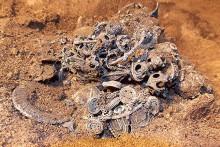Archaeologists have suggested that it hid in the earth noblewoman, hiding from the invasion of Batu
Source - http://ru-facts.com/news/view/42742.html

Archaeologists from Tver historical and archaeological research and restoration center, together with colleagues from the Institute of Archaeology RAS New Year’s Eve discovered during excavations in the building of the Tver Museum & ndash; directly under the floor of the cabinet director & ndash; treasure.
Under the floor of the cabinet general director of the museum at a depth of 2 meters, archaeologists found a small hole, where he finds a treasure, closed at the top inverted small ceramic vessels.
- under a bushel was set precious holiday jewelry belonging to a noble Tver townswoman - said & quot; Komsomolskaya & quot; leader of the expedition of the Institute of Archaeology RAS Russia Alexander Khokhlov. - Several tens of objects made of silver filigree and granulation technique. Among them & ndash; clasps (rings with mock delicate beads), probably decorated headdress, star and beam kolts and & ndash; Ryasna and chain, which append to hats and going down, skirting the face of the owner. The structure of the necklace of large and medium-sized inflated silver beads, includes three large round pendants, medallions. Decoration hands served a large silver bracelet flap decorated with engraved ornaments in the form of wicker and zoomorphic images made using the technique of filigree and black.
Scientists are not looking for treasure specifically, they are usually carried out rescue excavations in connection with the restoration of the former real school, where today is located Tver State United Museum.
- probably at the time of danger to the entire city, mistress treasure could not find another safe place, - says Alexander Khokhlov. - And then could not return to their treasures. She probably died in the assault of the city has been stolen or in full. It could find a treasure in the 15th century, when the sites studied was carried out large earthworks on vase life and leveling the ground. But medieval diggers do not get to the treasure of some 10-15 centimeters.
Director of the Institute of Archaeology Nikolai Makarov, in turn, noted that such treasures are traditionally associated with the Mongol invasion of 1237-1238 years.
Although the composition of things makes it impossible to date them within a few years, the whole of their relationship with the Mongol defeat of Russian cities is not in doubt, the horizon of fire and destruction of the middle of the 13th century can be traced in many ancient cities. And this finding expensive jewelry, were part of the female attire boyar in Tver, one of the & quot; young & quot; cities of the North-Eastern Russia, it is important to characterize its early history, it is evidence of the presence status of the nobility in Tver in the early 13th century, - noted the significance of the finds for archaeologists Nikolai Makarov.
Treasures found not all ancient cities, which, according to the Chronicle, were under attack Batu. In the north-eastern Russian lands they found in Vladimir (five treasures) and in Moscow (two clades), one treasure & ndash; famous & laquo; Suzdal Mantle & raquo; - Found in the mound near Suzdal.
A few years ago a treasure of jewelry was found in Torzhok, Tver land neighboring suburb of Novgorod, stubbornly resisted the Mongols. They are not in the Suzdal, Pereslavl-Zaleski, Yaroslavl, Rostov & ndash; cities, captured and burned by the Mongols. The largest number of hoards & ndash; 17 & ndash; found in the Old Ryazan.